
As many of you have noticed, there haven’t been enough available TAXIs. Demand far out-stripped supply, making you feel pretty lucky when you got a yellow from your iPhone. We did the best we could to get more yellows on the road, but New York’s TLC (Taxi and Limousine Commission) put up obstacles and roadblocks in order to squash the effort around e-hail.
Undoubtedly, some of that was because of pressure from the TLC. But part of the imbalance was that Uber doesn’t solve a meaningful problem in Manhattan.
[aditude-amp id="flyingcarpet" targeting='{"env":"staging","page_type":"article","post_id":559069,"post_type":"guest","post_chan":"none","tags":null,"ai":false,"category":"none","all_categories":"business,mobile,","session":"B"}']Uber essentially serves to create a more liquid and efficient market. But taxis in Manhattan are already a very liquid and efficient market. Cabs are everywhere and reasonably easy to get.
This is also true of other dense urban areas. I was in downtown Chicago earlier this year. At the time, Uber was testing its cab hailing service. It provided cab rides (up to $25) for free. Because I wanted to test the service and talk to cabbies about the experience, I took it as often as I needed a cab.
AI Weekly
The must-read newsletter for AI and Big Data industry written by Khari Johnson, Kyle Wiggers, and Seth Colaner.
Included with VentureBeat Insider and VentureBeat VIP memberships.
In one case, six open cabs drove by while I was waiting for my designated Uber cab to arrive. (I frequently had open cabs pass me while waiting for an Uber Taxi, but I only counted once.) If I weren’t testing the experience, I would just have taken one of those. There’s little value to me as a rider to wait when I can get an equivalent product right away.
In another case, after a baseball game at Wrigley, the cabbie showed up and couldn’t find me. He just picked up another fare because there were plenty to be had. If there’s a lot of demand, there’s little economic reason for a cabbie to drive even an extra mile with an empty cab to pick up a fare.
In areas that are densely populated with cabs, there’s a user experience problem. Most cabs look the same. You find yourself squinting to identify which driver is yours.
There’s an important distinction between incremental innovation and disruptive innovation. I consider something like Pay With Square, which allows consumers to pay for purchases by saying their name, an incremental innovation. Compare that with paying for parking with mobile phones. The first marginally improves an already highly efficient task (paying by swiping a credit card). The disruptive innovation solves a bigger problem (being able to pay a parking meter a few blocks away with a few clicks on your phone).
I’m a big fan of Uber’s sedan service. It is a disruptive innovation. It creates a much more efficient market and a significantly better user experience. It works especially well in cities like San Francisco and Washington, D.C., which have archaic cab systems. DC’s system feels like its from the 1960s. (And many of DC’s cabs look like they aren’t much newer.)
But hailing a cab in Manhattan is just not that hard. Most of the time.
[aditude-amp id="medium1" targeting='{"env":"staging","page_type":"article","post_id":559069,"post_type":"guest","post_chan":"none","tags":null,"ai":false,"category":"none","all_categories":"business,mobile,","session":"B"}']
There are two times when I’d really want to improve the cab experience: during shift change and during bad weather. It can be nearly impossible to find a cab during those times. But in those cases, there’s a significant excess of demand. A hack doesn’t have an economic incentive to drive out of his way to pick me up because everyone wants to be picked up.
Other elements of the experience aren’t significantly better. I don’t need a map of where the driver is if I can just walk to the curb and hail a cab in a few minutes. Paying automatically is nice, but it’s not the biggest problem that Uber solves.
Uber’s core value is to create a more efficient market and match supply with demand. Uber Taxi may work in some of the outer boroughs. But in the densest parts of New York, economic forces have already solved that problem.
[Top image credit: lalulu/Shutterstock]
[aditude-amp id="medium2" targeting='{"env":"staging","page_type":"article","post_id":559069,"post_type":"guest","post_chan":"none","tags":null,"ai":false,"category":"none","all_categories":"business,mobile,","session":"B"}']
VentureBeat's mission is to be a digital town square for technical decision-makers to gain knowledge about transformative enterprise technology and transact. Learn More